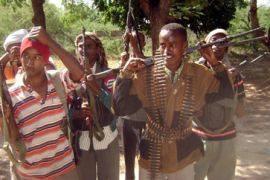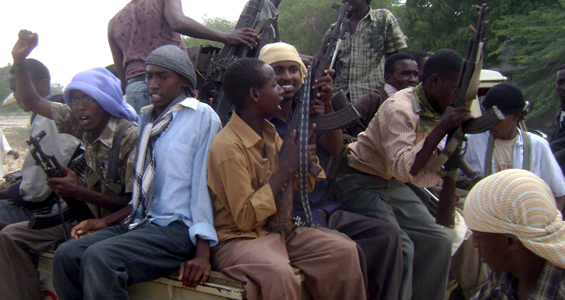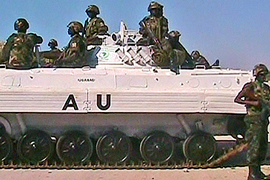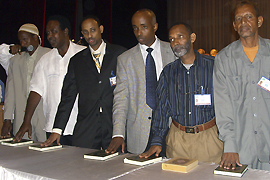Somalia’s long road to stability
Can a new president from an Islamist faction bring law and order to Mogadishu?

 |
| Islamic fighters in Somalia have moved into bases formerly occupied by Ethiopian troops [EPA] |
When the Ethiopian government announced the complete withdrawal of all of its troops from Somalia, the people of Mogadishu, the capital, took to the streets to celebrate the end of two years of occupation.
With the departure of Ethiopian troops, much of southern Somalia now comes under the control of various Islamist militias, who were once part of the Islamic Courts Union (ICU), the movement that Ethiopia – with American support – sought to destroy.
However, the Ethiopian withdrawal has created new challenges for Islamist groups as it no longer provides them with a unifying raison d’etre.
| In depth |
|
|
Groups like al-Shabab, the Ras Kamboni Brigades and other smaller factions, who control large swathes of southern Somalia, say they will continue fighting African Union (AU) peacekeepers and any other foreign troops in Somalia.
They also oppose the current government, even though other Islamists joined it.
On January 24, al-Shabab carried out a suicide bombing attack against AU peacekeepers.
Two days later, the group seized Baidoa, the seat of government and its last stronghold, hours after Ethiopian troops withdrew from the town.
Unity government
Despite al-Shabab’s military gains, other Islamist leaders, led by Sheikh Sharif Sheikh Ahmed, the former leader of the ICU, have called for an end to the violence and the formation of a unity government.
He has also urged the international community to send more peacekeepers to Somalia.
Sheikh Ahmed is currently attending UN-sponsored talks in Djibouti to form a new Somali government.
Somalia’s parliament approved a UN-mediated, power-sharing deal signed last year between the government and Sheikh Ahmed’s Alliance for the Re-Liberation of Somalia.
Based on the deal, 200 new MPs from his party were sworn in, joining the existing 225 government MPs.
Parliament’s next step will be to elect a new president who will in turn appoint a new prime minister.
New president
Sheikh Ahmed announced his candidacy for the post and joins a long list of contenders that includes Nur Adde, the current prime minister, and Ali Gedi and Ali Khalif Galaydh, both former prime ministers.
 |
| AU peacekeepers have been targeted in the continuing violence |
The former ICU leader is believed to be the front-runner as half of the MPs voting will be from his party.
His rise to power has been nothing short of meteoric.
Four years ago, Sheikh Ahmed was a judge presiding over one of the many tribal Sharia courts in Mogadishu.
In 2006, he joined the ICU and became the executive leader of the movement. Under his leadership, the UIC routed the US-bankrolled warlords and exerted their influence over Mogadishu and much of southern Somalia.
For about six months, the UIC brought stability and security to Mogadishu and the surrounding region, a feat that more than a dozen internationally recognised “transitional governments” failed to achieve.
Ethiopian invasion
In December 2006, Ethiopia invaded Somalia and put an end to the ICU’s rule. The weak but internationally recognised transitional government moved to Mogadishu from Nairobi, protected by Ethiopian troops.
The US regarded Sheikh Ahmed as a moderate in the ICU leadership, but placed other top leaders of the movement, including Sheikh Dahir Aweys, the spiritual leader of UIC, and al-Shabab leaders on its “terrorism” list.
When Kenya closed its border with Somalia and arrested several members of the UIC, following Ethiopia’s invasion, Sheikh Ahmed travelled to Nairobi where he spent several weeks.
In 2007, Sheikh Ahmed succeeded in bringing together opposition groups that included both Islamists and former government officials under his leadership, as fighters and Ethiopian troops clashed in Mogadishu.
Re-liberation alliance
The new group was named the Alliance for the Re-Liberation of Somalia (ARS) and was to be based in Asmara, the Eritrean capital.
 |
| Some 200 members of the ARS were sworn in to Somalia’s parliament in Djibouti [REUTERS] |
ARS maintained a two-fold approach to resolving Somalia’s political crises.
It supported the fighters engaging Ethiopian troops inside Somalia while simultaneously and indirectly negotiating with the government through the UN.
At the time, the new alliance represented the only viable political opposition to the government.
But in 2008, the alliance split as UN-sponsored talks between the government and ARS intensified.
Sheikh Ahmed believed that a UN-sponsored peace deal was the only means to end the Ethiopian occupation. Other ARS members, led by Sheikh Dahir Aweys, saw armed resistance as the only way forward.
Impossible task
Sheikh Ahmed subsequently moved from Asmara to Djibouti where the UN talks were taking place, after accusing Eritrea of interfering in ARS affairs. The Somali government and his ARS faction signed a power-sharing deal in July 2008.
Sheikh Ahmed has strong support in Mogadishu and is allied with ICU militias who control large parts of Mogadishu. Shortly before Ethiopia’s withdrawal, he returned to Mogadishu protected by AU peacekeepers and ICU militias.
Though the election of a new president may resolve some outstanding political issues, any Somali government formed in Djibouti will face the near impossible task of providing urgent humanitarian aid to millions of hungry Somalis and rebuilding government institutions.
With nearly half of the population in need of urgent humanitarian aid, the UN describes Somalia as “the worst crisis in Africa”.
However, the greatest challenge will be dealing with al-Shabab and other militias who already control much of the country and have vowed to fight any government that emerges in Djibouti.
There is also fear that if Sheikh Ahmed is elected president, clashes could erupt between his supporters and the al-Shabab militias in Mogadishu.
Since Somalia descended into civil war in 1992, more than 15 transitional governments have come and gone but violence has persisted.

 Timeline of Somalia
Timeline of Somalia